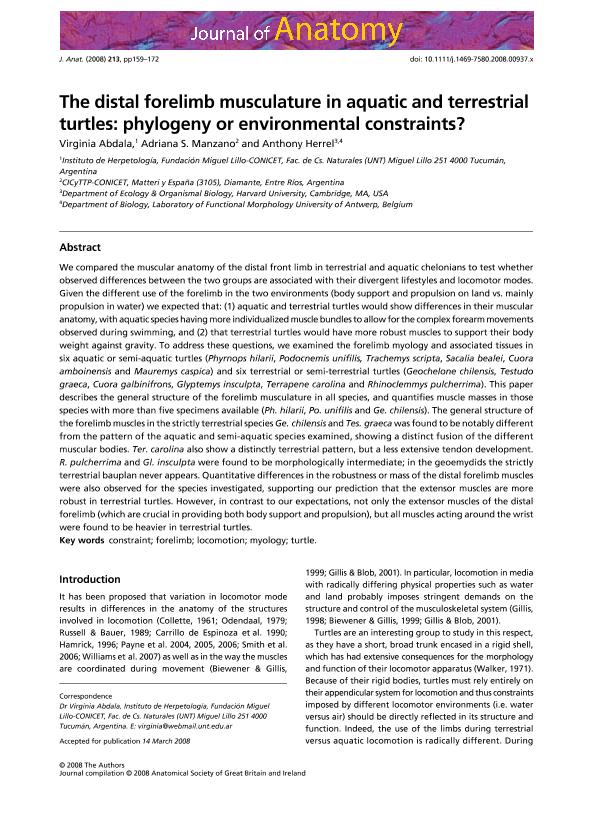Mostrar el registro sencillo del ítem
dc.contributor.author
Abdala, Virginia Sara Luz

dc.contributor.author
Manzano, Adriana Silvina

dc.contributor.author
Herrel, Anthony

dc.date.available
2019-07-15T15:52:42Z
dc.date.issued
2008-12
dc.identifier.citation
Abdala, Virginia Sara Luz; Manzano, Adriana Silvina; Herrel, Anthony; The distal forelimb musculature in aquatic and terrestrial turtles: phylogeny or enviromental constraint?; Wiley Blackwell Publishing, Inc; Journal of Anatomy; 213; 2; 12-2008; 159-172
dc.identifier.issn
0021-8782
dc.identifier.uri
http://hdl.handle.net/11336/79535
dc.description.abstract
We compared the muscular anatomy of the distal front limb in terrestrial and aquatic chelonians to test whether observed differences between the two groups are associated with their divergent lifestyles and locomotor modes. Given the different use of the forelimb in the two environments (body support and propulsion on land vs. mainly propulsion in water) we expected that: (1) aquatic and terrestrial turtles would show differences in their muscular anatomy, with aquatic species having more individualized muscle bundles to allow for the complex forearm movements observed during swimming, and (2) that terrestrial turtles would have more robust muscles to support their body weight against gravity. To address these questions, we examined the forelimb myology and associated tissues in six aquatic or semi‐aquatic turtles (Phyrnops hilarii, Podocnemis unifilis, Trachemys scripta, Sacalia bealei, Cuora amboinensis and Mauremys caspica) and six terrestrial or semi‐terrestrial turtles (Geochelone chilensis, Testudo graeca, Cuora galbinifrons, Glyptemys insculpta, Terrapene carolina and Rhinoclemmys pulcherrima). This paper describes the general structure of the forelimb musculature in all species, and quantifies muscle masses in those species with more than five specimens available (Ph. hilarii, Po. unifilis and Ge. chilensis). The general structure of the forelimb muscles in the strictly terrestrial species Ge. chilensis and Tes. graeca was found to be notably different from the pattern of the aquatic and semi‐aquatic species examined, showing a distinct fusion of the different muscular bodies. Ter. carolina also show a distinctly terrestrial pattern, but a less extensive tendon development. R. pulcherrima and Gl. insculpta were found to be morphologically intermediate; in the geoemydids the strictly terrestrial bauplan never appears. Quantitative differences in the robustness or mass of the distal forelimb muscles were also observed for the species investigated, supporting our prediction that the extensor muscles are more robust in terrestrial turtles. However, in contrast to our expectations, not only the extensor muscles of the distal forelimb (which are crucial in providing both body support and propulsion), but all muscles acting around the wrist were found to be heavier in terrestrial turtles.
dc.format
application/pdf
dc.language.iso
eng
dc.publisher
Wiley Blackwell Publishing, Inc

dc.rights
info:eu-repo/semantics/openAccess
dc.rights.uri
https://creativecommons.org/licenses/by-nc-sa/2.5/ar/
dc.subject
Constraint
dc.subject
Forelimb-Locomotion
dc.subject
Myology
dc.subject
Turtle
dc.subject.classification
Zoología, Ornitología, Entomología, Etología

dc.subject.classification
Ciencias Biológicas

dc.subject.classification
CIENCIAS NATURALES Y EXACTAS

dc.title
The distal forelimb musculature in aquatic and terrestrial turtles: phylogeny or enviromental constraint?
dc.type
info:eu-repo/semantics/article
dc.type
info:ar-repo/semantics/artículo
dc.type
info:eu-repo/semantics/publishedVersion
dc.date.updated
2019-07-10T14:40:56Z
dc.journal.volume
213
dc.journal.number
2
dc.journal.pagination
159-172
dc.journal.pais
Reino Unido

dc.journal.ciudad
Oxford
dc.description.fil
Fil: Abdala, Virginia Sara Luz. Consejo Nacional de Investigaciones Científicas y Técnicas. Centro Científico Tecnológico Conicet - Tucumán. Instituto de Biodiversidad Neotropical. Universidad Nacional de Tucumán. Facultad de Ciencias Naturales e Instituto Miguel Lillo. Instituto de Biodiversidad Neotropical. Instituto de Biodiversidad Neotropical; Argentina
dc.description.fil
Fil: Manzano, Adriana Silvina. Provincia de Entre Ríos. Centro de Investigaciones Científicas y Transferencia de Tecnología a la Producción. Universidad Autónoma de Entre Ríos. Centro de Investigaciones Científicas y Transferencia de Tecnología a la Producción. Consejo Nacional de Investigaciones Científicas y Técnicas. Centro Científico Tecnológico Conicet - Santa Fe. Centro de Investigaciones Científicas y Transferencia de Tecnología a la Producción; Argentina
dc.description.fil
Fil: Herrel, Anthony. University of Antwerp; Bélgica
dc.journal.title
Journal of Anatomy

dc.relation.alternativeid
info:eu-repo/semantics/altIdentifier/doi/https://dx.doi.org/10.1111/j.1469-7580.2008.00937.x
dc.relation.alternativeid
info:eu-repo/semantics/altIdentifier/url/https://onlinelibrary.wiley.com/doi/full/10.1111/j.1469-7580.2008.00937.x
Archivos asociados
